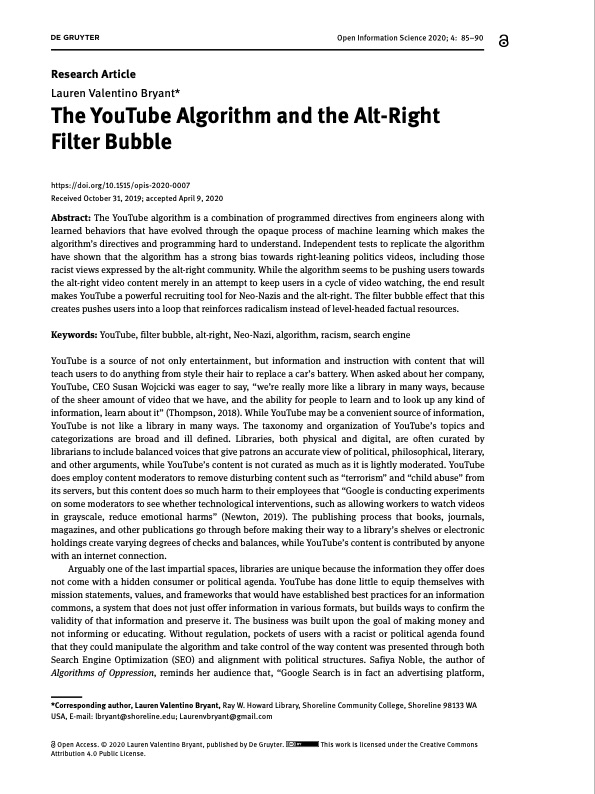
PDF Publication Title:
Text from PDF Page: 001
Research Article Lauren Valentino Bryant* The YouTube Algorithm and the Alt-Right Filter Bubble https://doi.org/10.1515/opis-2020-0007 Received October 31, 2019; accepted April 9, 2020 Abstract: The YouTube algorithm is a combination of programmed directives from engineers along with learned behaviors that have evolved through the opaque process of machine learning which makes the algorithm’s directives and programming hard to understand. Independent tests to replicate the algorithm have shown that the algorithm has a strong bias towards right-leaning politics videos, including those racist views expressed by the alt-right community. While the algorithm seems to be pushing users towards the alt-right video content merely in an attempt to keep users in a cycle of video watching, the end result makes YouTube a powerful recruiting tool for Neo-Nazis and the alt-right. The filter bubble effect that this creates pushes users into a loop that reinforces radicalism instead of level-headed factual resources. Keywords: YouTube, filter bubble, alt-right, Neo-Nazi, algorithm, racism, search engine YouTube is a source of not only entertainment, but information and instruction with content that will teach users to do anything from style their hair to replace a car’s battery. When asked about her company, YouTube, CEO Susan Wojcicki was eager to say, “we’re really more like a library in many ways, because of the sheer amount of video that we have, and the ability for people to learn and to look up any kind of information, learn about it” (Thompson, 2018). While YouTube may be a convenient source of information, YouTube is not like a library in many ways. The taxonomy and organization of YouTube’s topics and categorizations are broad and ill defined. Libraries, both physical and digital, are often curated by librarians to include balanced voices that give patrons an accurate view of political, philosophical, literary, and other arguments, while YouTube’s content is not curated as much as it is lightly moderated. YouTube does employ content moderators to remove disturbing content such as “terrorism” and “child abuse” from its servers, but this content does so much harm to their employees that “Google is conducting experiments on some moderators to see whether technological interventions, such as allowing workers to watch videos in grayscale, reduce emotional harms” (Newton, 2019). The publishing process that books, journals, magazines, and other publications go through before making their way to a library’s shelves or electronic holdings create varying degrees of checks and balances, while YouTube’s content is contributed by anyone with an internet connection. Arguably one of the last impartial spaces, libraries are unique because the information they offer does not come with a hidden consumer or political agenda. YouTube has done little to equip themselves with mission statements, values, and frameworks that would have established best practices for an information commons, a system that does not just offer information in various formats, but builds ways to confirm the validity of that information and preserve it. The business was built upon the goal of making money and not informing or educating. Without regulation, pockets of users with a racist or political agenda found that they could manipulate the algorithm and take control of the way content was presented through both Search Engine Optimization (SEO) and alignment with political structures. Safiya Noble, the author of Algorithms of Oppression, reminds her audience that, “Google Search is in fact an advertising platform, *Corresponding author, Lauren Valentino Bryant, Ray W. Howard Library, Shoreline Community College, Shoreline 98133 WA USA, E-mail: lbryant@shoreline.edu; Laurenvbryant@gmail.com Open Access. © 2020 Lauren Valentino Bryant, published by De Gruyter. This work is licensed under the Creative Commons Attribution 4.0 Public License. Open Information Science 2020; 4: 85–90PDF Image | YouTube Algorithm and the Alt-Right Filter Bubble

PDF Search Title:
YouTube Algorithm and the Alt-Right Filter BubbleOriginal File Name Searched:
The_YouTube_Algorithm_and_the_Alt-Right_Filter_Bub.pdfDIY PDF Search: Google It | Yahoo | Bing
Cruise Ship Reviews | Luxury Resort | Jet | Yacht | and Travel Tech More Info
Cruising Review Topics and Articles More Info
Software based on Filemaker for the travel industry More Info
The Burgenstock Resort: Reviews on CruisingReview website... More Info
Resort Reviews: World Class resorts... More Info
The Riffelalp Resort: Reviews on CruisingReview website... More Info
| CONTACT TEL: 608-238-6001 Email: greg@cruisingreview.com | RSS | AMP |